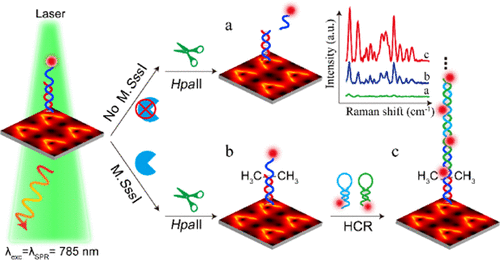Our official English website, www.x-mol.net, welcomes your feedback! (Note: you will need to create a separate account there.)
Sensitivity-Improved SERS Detection of Methyltransferase Assisted by Plasmonically Engineered Nanoholes Array and Hybridization Chain Reaction
ACS Sensors ( IF 8.9 ) Pub Date : 2020-11-04 , DOI: 10.1021/acssensors.0c02016 Xiaojun Luo 1 , Tuli Kang 1 , Jingtian Zhu 1 , Ping Wu 1 , Chenxin Cai 1
ACS Sensors ( IF 8.9 ) Pub Date : 2020-11-04 , DOI: 10.1021/acssensors.0c02016 Xiaojun Luo 1 , Tuli Kang 1 , Jingtian Zhu 1 , Ping Wu 1 , Chenxin Cai 1
Affiliation

|
Detection of methyltransferase (MTase) activity is of great significance in methylation-related disease diagnosis and drug screening. Herein, we present a dual-amplification sensing strategy that is assisted by plasmonically enhanced Raman intensity at engineered nanoholes array, along with signal amplification by the hybridization chain reaction (HCR) for the ultrasensitive detection of M.SssI MTase activity and inhibitor screening. An engineered surface-enhanced Raman scattering (SERS) substrate, namely, a structured nanoholes array (NHA) with wavelength-matched surface plasmon resonance (SPR) at the wavelength of laser excitation (785 nm), was rationally designed through finite-difference time-domain (FDTD) simulations, precisely fabricated through master-assisted replication, and then used as a sensing platform. Uniform and intense SERS signals were achieved by turning on the plasmonic enhancement under the excitation of SPR. Probe DNA was designed to hybridize with target DNA (a BRCA1 gene fragment), and the formed dsDNA with the recognition site of M.SssI was assembled on the NHA. In the presence of M.SssI, the HCR process was triggered upon adding DNAs labeled with the Raman reporter Cy5, leading to an amplified SERS signal of Cy5. The intensity of Cy5 increases with increasing M.SssI activity, which establishes the basis of the assay for M.SssI. The developed assay displays an ultrasensitivity that has a broad linear range (0.002–200 U/mL) and a low detection limit (2 × 10–4 U/mL), which is superior to that of the reported SERS-based detection methods. Moreover, it can selectively detect M.SssI in human serum samples and evaluate the efficiency of M.SssI inhibitors.
中文翻译:

等离子体工程纳米孔阵列和杂交链反应辅助提高甲基转移酶的SERS检测灵敏度
甲基转移酶(MTase)活性的检测在甲基化相关疾病的诊断和药物筛选中具有重要意义。在本文中,我们提出了一种双重放大传感策略,该方法由工程纳米孔阵列上的等离子体增强拉曼强度以及通过杂交链反应(HCR)进行信号放大的超灵敏检测M. Sss所辅助I MTase活性和抑制剂筛选。通过有限差分时间合理设计了工程化的表面增强拉曼散射(SERS)衬底,即在激光激发波长(785 nm)处具有波长匹配的表面等离子体共振(SPR)的结构化纳米孔阵列(NHA)。域(FDTD)模拟,通过主辅助复制精确地制造,然后用作传感平台。通过在SPR的激发下开启等离子体增强来获得均匀而强烈的SERS信号。设计探针DNA与靶DNA(BRCA1基因片段)杂交,并将形成的具有M.Sss I识别位点的dsDNA组装在NHA上。在M. Sss面前I,在添加标记有拉曼报告基因Cy5的DNA时触发了HCR过程,导致Cy5的SERS信号放大。Cy5的强度随M. Sss I活性的增加而增加,这为M. Sss I的测定奠定了基础。已开发的测定法显示了超宽线性范围(0.002-200 U / mL)和低检测灵敏度极限(2×10 –4 U / mL),优于已报道的基于SERS的检测方法。此外,它可以选择性地检测人血清样品中的M. Sss I,并评估M. Sss I抑制剂的效率。
更新日期:2020-11-25
中文翻译:

等离子体工程纳米孔阵列和杂交链反应辅助提高甲基转移酶的SERS检测灵敏度
甲基转移酶(MTase)活性的检测在甲基化相关疾病的诊断和药物筛选中具有重要意义。在本文中,我们提出了一种双重放大传感策略,该方法由工程纳米孔阵列上的等离子体增强拉曼强度以及通过杂交链反应(HCR)进行信号放大的超灵敏检测M. Sss所辅助I MTase活性和抑制剂筛选。通过有限差分时间合理设计了工程化的表面增强拉曼散射(SERS)衬底,即在激光激发波长(785 nm)处具有波长匹配的表面等离子体共振(SPR)的结构化纳米孔阵列(NHA)。域(FDTD)模拟,通过主辅助复制精确地制造,然后用作传感平台。通过在SPR的激发下开启等离子体增强来获得均匀而强烈的SERS信号。设计探针DNA与靶DNA(BRCA1基因片段)杂交,并将形成的具有M.Sss I识别位点的dsDNA组装在NHA上。在M. Sss面前I,在添加标记有拉曼报告基因Cy5的DNA时触发了HCR过程,导致Cy5的SERS信号放大。Cy5的强度随M. Sss I活性的增加而增加,这为M. Sss I的测定奠定了基础。已开发的测定法显示了超宽线性范围(0.002-200 U / mL)和低检测灵敏度极限(2×10 –4 U / mL),优于已报道的基于SERS的检测方法。此外,它可以选择性地检测人血清样品中的M. Sss I,并评估M. Sss I抑制剂的效率。



























 京公网安备 11010802027423号
京公网安备 11010802027423号